Ten Years After
Photographs by John Douglas
Text by Laura Stephenson Carter
In 1994, we profiled several "typical" medical students, exploring in text and photographs what life at DMS was really like. Now, 10 years later, we return to take another look at those profilees' lives. Where are they today? What are they doing? And what do they think the next 10 years will bring?
The Summer 1994 issue of Dartmouth Medicine included a photo-feature highlighting the lives of several DMS students. A writer and a photographer followed them to the classroom and the library; in the wards and clinics; even as they sang and coached and jogged on their own time. We wanted to reveal what the life of a few typical medical students was really like.
John Douglas, the photographer who documented that story, wondered recently how those students—now alumni—were doing and suggested that we do a follow-up story on them. So we have. In this issue, we review where these three are now. It was only fitting that Douglas be the photographer for this article, too.
Jane Auger was a first-year student in the Brown- Dartmouth program in 1994. She'd been teaching radiologic technology and was 37 years old when she entered DMS. But as she plunged into the rigorous medical-school schedule, she made sure she still had time for the extracurricular activities she loved—gardening, singing, and ballroom and contra dancing. Now she's a staff radiologist in private practice in Massachusetts. And she's still gardening, singing, and dancing.
Benjamin Gardner was a second-year student in 1994. He had started medical school at the age of 43, after a 20-year career as a developer. He had a wife and four children, the eldest of whom would graduate from high school the same year he graduated from DMS. All through medical school, Gardner coached and managed sports programs. He is now the staff physician, as well as a lacrosse and hockey coach, at Choate Rosemary Hall, a private secondary school in Connecticut.
Angela Erdrich was just finishing medical school in 1994 and about to start a residency in pediatrics at the University of Washington in Seattle. She'd always dreamed of working for the Indian Health Service, and that's exactly what she's doing now. And she is so devoted to patient care that even when she's not seeing patients, she's involved with various community-outreach projects that focus on building health awareness.
"In some ways," mused the 1994 story (which was written by the magazine's now-retired associate editor, Rosemary Lunardini), "each of these students reflects what all medical students are like and what their lives require of them. But each is unique, too." Perhaps 10 years from now, we'll do another update on our 1994 examplars—another inside look at some typical but unique everyday lives.
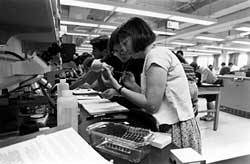
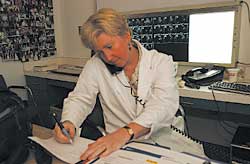 |
|
In 1994, Jane Auger (above, right) was staining slides in microbiology lab . . . and now she's a busy radiologist in private practice in Massachusetts. |
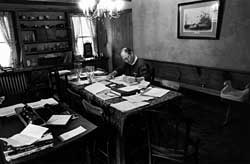
 |
|
In 1994, Ben Gardner spent most evenings studying at the dining room table . . . and now he's the staff doctor at a boarding school in Connecticut. |

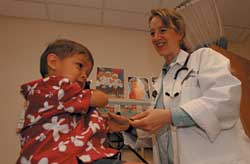 |
|
In 1994, Angie Erdrich was about to head out from DMS for residency . . . and now she's a pediatrician with the Indian Health Service in North Dakota. |

It was a leap of faith for Jane Auger to leave behind her established career to come to medical school. When she entered DMS, she was the chair of radiography education at Massasoit Community College in Brockton, Mass., and before that she'd been director of the radiology tech program at Goddard Memorial Hospital in Stoughton, Mass.
She knew her decision would mean living without an income for several years, but she's never regretted the choice she made. "I thought this was a good investment, and that I would just try to do it," she told Dartmouth Medicine in 1994. "I figured I would just take one step at a time."
And so she has. First she finished medical school, in 1997. (As a student in the Brown-Dartmouth program, she completed two years of basic science courses at DMS, followed by two years of clerkships at Brown.) Next, she did a residency in radiology at Brown and a fellowship at Brigham and Women's in Boston. Then, in 2002, she landed a job as a staff radiologist in a private radiology practice in Norwood, Mass.
  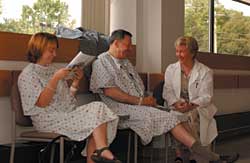 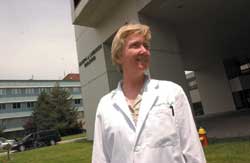 |
There was a brief period when Auger was tempted to enter a specialty other than radiology— surgery. "I really did like surgery, but I felt like I couldn't probably survive surgery at my age," she explains. "That's the difference that being older made to me, that I was more realistic about what my limitations would be. Not just physically, but what I wanted out of life. I didn't want to do an eightyear residency. Five years for radiology was long enough."
Still she's surprised at how few obstacles there seemed to be along the way. "I thought there were going to be more problems with my being the age that I am than there were," she says. "I did remarkably well for an old lady." She laughs. "I was able to keep up with things. I wasn't more tired than anybody else was after a 24-hour shift. I attribute a lot of that to having Nate as such a good support system." She met Nate Goldshlag, an electrical engineer, at a Cajun dancing event in 1997. They got married in 1998.
Having had training and experience as a radiologic technician has given Auger some advantages over her fellow radiologists. For one thing, she can communicate better with the radiology technicians— the people who actually take the x-rays that the radiologists then interpret— than most of her colleagues. "I'd say, 'I really need this specific view, can you do it?'" If the technicians ever seem uncertain, she simply shows them what she means—and then confesses that she used to be an x-ray tech herself. The technicians appreciate the fact that she never asks them to do something impossible. "That [gets] me a lot of good will," she says.
But as much as she knew about radiology before, she learned a great deal more in medical school. "For every tiny bone that you learn, you find out that there's 30 parts to it and each one has a different name," she says. "There are layers and layers of complexity that you don't even appreciate—that you don't even know exist—until you start delving into it."
Even as she is consumed by her career, she manages to find time for a lot of outside activities. She still loves gardening, dancing, singing, and just romping with her dog, a Lab-coonhound mix named Smudge. When she was at DMS, she sang with Dartmouth's Handel Society Chorus, as well as with the DMS Dermatones, an a cappella group that she started with several classmates. This fall she'll be auditioning for the Masterworks Chorale in Lexington, Mass.
But she most definitely loves her job. "It's been great because it seems like a whole continuum," she says. "I started as a tech, and then I taught other techs, and then I went back to school to be a radiologist. So it's like coming full circle."
Ten years from now, she hopes to still be working for the same radiology practice—and perhaps teaching residents and medical students, too, further rounding out the circle of her career.

Ben Gardner was a resident at DHMC when he learned that the doctor at Choate Rosemary Hall, a prep school in Wallingford, Conn., was planning to retire. It was Gardner's dream job, and he recalls phoning the physician from the DHMC on-call room to ask about it. But the doctor said, "Forget it—there's a long line, and I already know who's going to take my place."
Gardner, like Auger, was an older student when he entered DMS. He had spent 20 years as a developer— building vacation homes, hotels, and inns in central Vermont—while also serving as a ski patroller, EMT instructor, and head of the Rutland, Vt., Regional Medical Center board of directors. During his time at DMS, he coached lacrosse and ice hockey and was president of the Hanover Youth Hockey Association. In 1994, he'd completed his second year and was about to enter his clerkships.
During the various clinical rotations that filled his third and fourth years of med school, he discovered how much he liked pediatrics, especially adolescent medicine. After graduating in 1996, he did a residency in pediatrics at DHMC and worked with adolescents as much as he could.
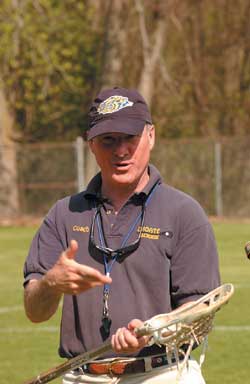 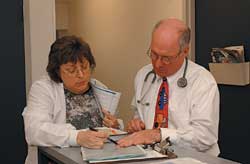 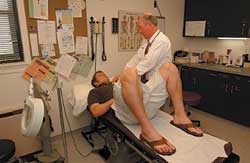 |
He didn't have time to coach during residency, but, as the physician for the Hanover High School football team, he got to tend to the medical needs of teenaged athletes.
He also treated adolescents at the Dartmouth- Hitchcock Clinic in Concord, N.H., and at Dick's House, the Dartmouth College infirmary. In addition, he was a contract physician for two New Hampshire prep schools—Kimball Union Academy in Meriden and Phillips Exeter Academy in Exeter. He asked a few prep-school doctors for advice on how to snare a job like theirs. "Of course they laughed," Gardner recalls, "because there are only six or seven of those positions. They told me that somebody had to die or retire."
Luckily for Gardner, the retiring doctor at Choate was wrong. The school didn't hire a replacement right away and used community doctors instead. By the time Choate was ready to recruit a staff physician, Gardner was looking for a job. He convinced school officials that his maturity and experience as a parent and a coach, as well as his own prep-school experience (he is an alumnus of Phillips Andover Academy in Andover, Mass.), made him a perfect candidate for the job. "A lot of the issues [for] a prep-school doctor are relating to parents and knowing how to deal with situations," he says. "So it wasn't like I was a youngster," despite the fact that he had just barely completed residency. He also had strong recommendations from members of the faculty at Dartmouth. He got the job.
Now in his fifties, and with three of his four children in their twenties, Gardner thrives on his busy schedule. He doesn't mind being either on duty or on call seven days a week, 24 hours a day, during the 10 months of the year that school is in session. "I live on campus. I'm available," he says. He loves the fact that he can walk from his house to his office across campus. He sees patients almost every day, coaches lacrosse in the spring and ice hockey in the winter, advises students, and has a number of other responsibilities.
Evenings are jam-packed with activities, too—faculty meetings, supervising a dorm once a week, attending away games, teaching health-education classes. He usually has Sunday afternoons off, though he's on call. During spring break he takes the lacrosse team to Florida for preseason training. He even spends part of the summer at Choate while sports camps are in session. He does, however, spend August relaxing—kayaking, golfing, and sailing—usually at his condo in Grantham, N.H.
Sadly, his marriage didn't survive the rigors of changing careers. It dissolved about the time he was completing his residency. But everyone's on good terms and he's very much a part of his children's lives.
And where does Gardner see himself in another 10 years? Probably still working (and coaching) at Choate.

"I always planned on working for the Indian Health Service, and I am proud to say I have lived up to that," says Angela Erdrich, who is one-quarter Turtle Mountain Chippewa (and the sister of noted novelist Louise Erdrich, a 1976 graduate of Dartmouth College). She and her husband— pediatrician Sandeep Patel, M.D., M.P.H., whom she met during residency—both work on the Turtle Mountain Chippewa Reservation in Belcourt, N.D.
In 1994, Angie Erdrich was about to earn her second Dartmouth degree. She'd graduated from Dartmouth College in 1987, as an art major, and would soon add a Dartmouth M.D. to her resume; she'd been accepted into a pediatric residency program at the University of Washington in Seattle.
After finishing her residency, she worked for three years on the Oneida Reservation in Wisconsin, then for almost two years on the Navajo Reservation in Chinle, Ariz. "I will carry my experiences with the Oneida and Navajo people forever in my heart," she says. "I wish I could have stayed to work at these places, but I needed to be closer to home."
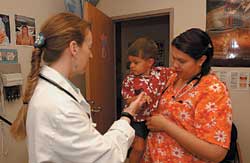 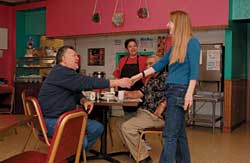 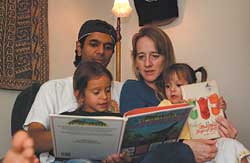 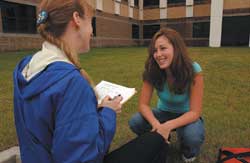 |
So in June 2002, she and her husband moved to Belcourt, which is only 300 miles from Erdrich's hometown of Wahpeton, N.D. Her mother even grew up on the very reservation where Erdrich now works, in an 1880 log house that the family still owns.
Erdrich and her husband keep pretty busy raising their children—son Avinash, 5, and daughters Hema, 31/2, and Saheli, 21 months; seeing patients; and participating in a number of community activities. They have produced six community-healtheducation calendars that feature photographs of local people who serve as examples of good health.
"My heart is in patient education," Erdrich says. "A doctor can only do so much patient education in the office, one-on-one. My goal is to share positive health messages with a wider audience in a format that is catchy. As a bonus, I think the calendar helps promote community pride."
Erdrich and her husband also give public presentations on nutrition and diabetes prevention. They are involved with smoking prevention projects. They formed a local chapter of Reach Out and Read, a national program that provides books to pediatric patients. And the couple started a vegetable and flower garden on the grounds of the hospital where they work "to promote healthy, natural foods as a way of preventing diabetes," explains Erdrich.
The garden is "all black tarp because the weather is really cold here," she says. The dark surface of the tarp soaks up solar radiation, which then warms the ground. But, rues Erdrich, between the cold climate and a short growing season, even the garden is no guarantee that people will get enough fresh fruits and vegetables. "It's such a big problem for people in rural areas to get healthy food and fresh food," she says. "I have patient handouts that mention local places that might have healthy bread and that kind of thing." She also uses visual aids to make the point about healthy eating. "We have these big sugar containers in our office that we show: 'If you had one [soda] pop a day for 14 days, you'd have this much extra sugar in your body.'"
Erdrich has received media attention for her community outreach work, the reading program, and her calendar project. And she was one of 300-some women selected for inclusion in an interactive, multimedia exhibition at the National Library of Medicine called "Changing the Face of Medicine."
She loves her work as a pediatrician. "You get to be an advocate for children," she says. "I especially like to take care of a child with a really complicated medical problem where you can help them navigate the confusing and intimidating medical system."
Where does she see herself in 10 years? "We plan to stay," she says, then hesitates. "You never know if a job is going to go—not be right for you eventually—but right now we feel like we plan to stay."
Laura Carter has been Dartmouth Medicine's associate editor for the past five years, and John Douglas has been one of the magazine's regular freelance photographers since the late 1980s. His work usually bears the credit line "Flying Squirrel Graphics."
If you would like to offer any feedback about this article, we would welcome getting your comments at DartMed@Dartmouth.edu.
